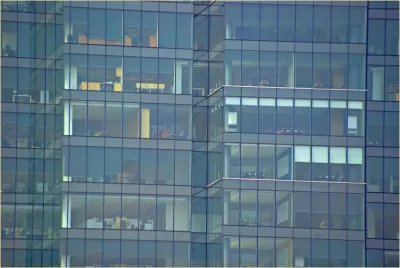An online calculator helps companies determine the broader impacts of their decisions to continue working remotely or return to the office.

Although remote work seems climate-friendly, "the reality is more complicated," writes Sarah Holder in Bloomberg CityLab. A new tool from Watershed Technology Inc. can help companies calculate the environmental impact of returning to the office or letting their employees continue working from home.
Watershed's website explains that, while remote work reduces the energy used in offices, it "shifts carbon: Emissions from energy and food still exist, but at employees’ homes, where they may be better or worse than in the office." Additionally, "a decentralized workforce might lead to more quarterly trips to meet face-to-face," and an exodus to the suburbs could mean increased carbon footprints for more households. The calculator lets companies "assess their greenhouse emissions more holistically, from the power their offices consume to the fuels burned in their supply chain" in order to "measure their impact, make plans to reduce it and make reports on progress."
When it comes to whether remote work is greener than returning to the office, "geography matters," says Holder. "The data analytics company ENGIE Impact suggested that if car commuting is already the status quo for employees at a given office, 'a reduction in commuting is the most reliable way to reduce carbon — even after factoring in the potential for increased energy use in a WFH environment.'" For companies whose employees already relied heavily on public transit, the reduction in carbon will be less impactful. According to Watershed, "the differences between cities are a result of different average household emissions per city, different electricity emissions based on which grid the city is a part of, and the mix of power generation for the grid, as well as average commute distances and respective transport mix for each city."
FULL STORY: The Environmental Implications of the Return to the Office

Alabama: Trump Terminates Settlements for Black Communities Harmed By Raw Sewage
Trump deemed the landmark civil rights agreement “illegal DEI and environmental justice policy.”

Planetizen Federal Action Tracker
A weekly monitor of how Trump’s orders and actions are impacting planners and planning in America.

The 120 Year Old Tiny Home Villages That Sheltered San Francisco’s Earthquake Refugees
More than a century ago, San Francisco mobilized to house thousands of residents displaced by the 1906 earthquake. Could their strategy offer a model for the present?

Ken Jennings Launches Transit Web Series
The Jeopardy champ wants you to ride public transit.

BLM To Rescind Public Lands Rule
The change will downgrade conservation, once again putting federal land at risk for mining and other extractive uses.

Indy Neighborhood Group Builds Temporary Multi-Use Path
Community members, aided in part by funding from the city, repurposed a vehicle lane to create a protected bike and pedestrian path for the summer season.
Urban Design for Planners 1: Software Tools
This six-course series explores essential urban design concepts using open source software and equips planners with the tools they need to participate fully in the urban design process.
Planning for Universal Design
Learn the tools for implementing Universal Design in planning regulations.
Clanton & Associates, Inc.
Jessamine County Fiscal Court
Institute for Housing and Urban Development Studies (IHS)
City of Grandview
Harvard GSD Executive Education
Toledo-Lucas County Plan Commissions
Salt Lake City
NYU Wagner Graduate School of Public Service





























